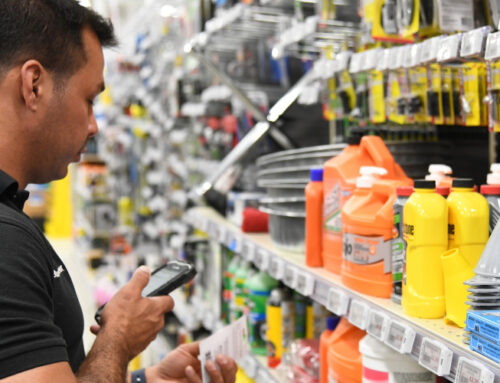According to the National Retail Federation (NRF) and Happy Returns 2024 Customer Returns in the Retail Industry Report, retailers estimated that 16.9% of their annual sales in 2024 were returned, making customer returns a headache for many retailers, regardless of their size. And customers are not making it any easier on retailers; the NRF report found that 67% of consumers said a negative returns experience would discourage them from shopping with a retailer again and 84% of consumers report being more likely to shop with a retailer that offers no box/no label returns and immediate refunds.
In its 2024 How Important Are Returns to Customers report, Appriss Retail, a software company specializing in omnichannel retail fraud and abuse protection, uncovered similar sentiments from customers. The report found 55% of consumers have decided not to buy from retailers due to restrictive returns policies, 31% stopped shopping at certain retailers due to negative returns experiences and 70% of consumers made additional purchases due to positive returns interactions.
These numbers don’t only apply to larger
businesses; customers of small and medium-size businesses also have the same high standards when it comes to returns.
Pedro Ramos, Appriss Retail chief revenue officer, says independent retailers who don’t take a proactive approach to creating effective returns policies that fight fraud and satisfy customers expectations are just as vulnerable as larger, big-box retailers or department stores.
“Shoppers have become familiar with open and flexible returns policies ever since the e-commerce boom and expect an efficient, frictionless returns process
both online and in-store,” Ramos says. “When that doesn’t happen, the shopper’s loyalty to the retailer is negatively impacted.”
Being able to offer a seamless returns policy while still keeping down costs and avoiding fraud can be a challenging balancing act for retailers. To guide retailers as they develop their policies, several retailers share their returns policies and the ways they have found to mitigate fraud and keep customers satisfied.
Keys to an Effective Returns Policy
When developing returns policies, many retailers are turning to blanket policies and restrictions or specific rules engines that apply to everyone across the board, Ramos says.
“An effective return policy is not one-size-fits-all, it is one that considers a customer’s entire shopping history and behavior with the retailer,” Ramos says. “A blanket policy only harms customer loyalty in the long run as honest customers are treated the same as fraudsters.”
Ramos says the future of returns lies in utilizing technology and artificial intelligence (AI) to consider a customer’s total value to the retailer and create individualized decisions that stop fraudsters while maintaining seamless returns for honest shoppers.
“Retailers can now leverage technologies that organize their data effectively. By unifying transaction data, shopper information and inventory management across all channels, AI-driven returns authorization technology can accurately identify fraudsters and introduce friction into fraudulent transactions, all while safeguarding honest customers,” Ramos says. “With fraudulent returns and claims on the rise, retailers must harness their customer data to minimize these losses effectively.”
AAA Paint & Supply in Tempe, Arizona, is a small store with a small number of returns, but owners Andy and Jessica Blatnick know a clear returns policy is important no matter the size of your operation.
“Every store needs a returns policy,” Andy says. “We had a customer when we first opened who returned tinted paint because we did not have on the receipt that tinted materials are non-refundable. It’s important to be clear even when you don’t think you need to be.”
The main part of the store’s returns policy is printed on the bottom of the receipts: A receipt is needed for
refund or exchange, there are restocking charges on custom orders and tinted materials are non-refundable. Returns should be made within 30 days of purchase and the restocking charge is a minimum of 20%.
“As long as the product is in good resalable condition and has not been discontinued or something along those lines, we are usually accommodating for returns beyond that point,” Andy says. “We try to look at each individual circumstance.”
The store’s returns policy is simple with a foundation in customer service. Blatnick says that they work closely with each customer to be sure they are getting the right product for the project they are working on.
The store uses online training from the North American Hardware and Paint Association (NHPA) and Benjamin Moore to keep employees up to date and knowledgeable to ask the right questions in guiding customers in their project from start to finish to hopefully avoid the customer needing to return a product.
“We work with paint all the time, so tell customers up front that once they choose the color, the paint is theirs,” Andy says. “We have a relationship with nearly every customer who comes in, which allows us to qualify most purchases before they become returns. We also track just about every customer by their phone number, so we have a good record of what was purchased and by whom, which cuts down on fraudulent returns.”
If the product is defective, Blatnick says they take care of the return within 30 days or get the manufacturer involved if needed. Overall, customers are understanding of the store’s returns policy.
“Every so often we get someone wanting to return the paint for one reason or another,” Blatnick says. “We inform them that we can adjust the color some, but we cannot return the paint. A little customer service goes a long way.”
At Norberg Paints, with two locations in Sioux Falls, South Dakota, the customer returns policy is simple and logical, says director Nick Hauert. Unopened and untinted paint products in good condition can be returned within 60 days of purchase and supplies, sundries and items without a shelf life can be returned for a full refund at any time with a receipt.
“We have always tried to keep the returns policy very straightforward and logical,” Hauert says. “Because of our straightforward policy, we have not really had any problems with customers on returns. Once things are explained, people generally understand policies as long as they make sense.”
In the rare cases where a customer tries to return a product purchased from a competitor or a product that is not in new condition, Hauert says the store will not take the product back but will offer the customer the store’s preferred customer discount on future purchases.
“Hopefully this gesture will satisfy them at the time and bring them back to the store in the future,” Hauert says.
For Amy Earls, vice president of Page Hardware & Appliance Co. in Guilford, Connecticut, developing a customer returns policy for the operation was necessary to set customer expectations, protect the business and help employees understand what answers to give to customers. As they were developing the customer returns policy, Earls says they read through the returns policies for other area businesses and competitors.
“We want to remain competitive in the convenience factor that returns can offer,” Earls says. “We did our best to write a policy that is fair and protects our company, but is also a policy that our employees feel comfortable enforcing.”
Components Page Hardware’s returns policy include:
- Any returns made within 60 days of date of purchase with original receipt are eligible for a full refund
- Returns without a receipt receive store credit in the amount of the item’s lowest sale price
- Refunds for purchases made with a credit card or debit card will only be credited to the card used to make the purchase, unless approved by a manager
- Items returned must be in new, unused condition, including all original packaging, manuals and accessories
- Cashiers may request a customer’s full name, address and phone number on all returns
Avoid Running on Autopilot
Once a policy is in place, retailers should continually evaluate its effectiveness. Hauert says that the stores have had to be more strict on requiring receipts or documentation for returns to avoid refunding more than the original purchase price.
“We do not want to give a full-price refund on a product that was purchased at a discount or give a refund on a product that had a recent price increase at the new, higher price,” Hauert says.
To stay competitive and serve customers with the highest level of service, Page’s returns policy has evolved many times over the years, Earls says.
“I was recently going through some old files and came across merchandise returns slips that we used to use in the 1980s,” Earls says. “The cashier had to fill out customer information, product details, how the refund was made and get a customer signature.”
Today, the returns process is easier and automated. The store utilizes Epicor’s Returns Validation, so employees processing returns only need to ask for a phone number to find the customer’s purchase information. After Epicor introduced the ability to return money directly to a gift card, the store set a time frame for returning to the original tender, which is currently 60 days.
“We used to collect returns in a box and the manager reviewed them at the end of the day, prior to putting the product back on the shelf,” Earls says. “Problems were rarely discovered and the process created issues because the inventory was not on the shelf, so we no longer require manager review.”
Another major evolution was the move to process all returns at one desk. Earls says they remodeled the store in 2012, adding a service desk near the key machine, and began processing all returns at that desk. Previously, returns were processed at all cash registers. Having one desk to process returns eliminated having customers who were making purchases waiting in line behind unhappy customers looking to return defective products. Returns often take longer than sales, so the move sped up the point-of-sale process.
“Limiting returns to the service desk also reduces the number of employees who need to be trained on the return process, which in turn reduces processing errors and inconsistent messaging to customers about what is allowed,” Earls says.
Fighting Returns Fraud
Appriss Retail’s 2024 Consumer Returns in the Retail Industry report also took a closer look at the impact of returns fraud. In 2024, total returns for the retail industry reached $685 billion and the total returns rate as a percentage of sales for 2024 was 13.21%. Of those returns, 15.14% were fraudulent, totaling $103 billion.
Fortunately for Earls, overall customers are pleased with the store’s returns policies and the store has experienced minimal returns fraud. She says customers are often surprised they can make returns beyond 30 days, and the people who are unhappy about the policy are usually ones who are trying to return a product that they bought a year ago or from another store, or they are trying to pass off a used product as new or a working product as defective.
When it comes to fraud, there are a couple of customers who the employees know to watch out for and the service desk employees and managers know when to be firm and refuse a return.
“For the most part, we make the returns process easy and quick, to be convenient,” Earls says. “Customers appreciate this, and since they don’t need to be sneaky to get credit, it encourages honesty.”
7 types of Return Fraud to Watch Out For
In order to guard against returns fraud in your operation, you need to be knowledgeable on the types of fraud customers could use against your business.
-
Wardrobing
Buying an item, using it for a time and then returning it for a full refund.
-
Price Switching
Putting a lower-priced sticker on a higher-priced item before purchasing and then returning for a refund at the actual higher price.
-
Return Stolen Merchandise
Attempting to return an item that has been stolen from the store by using a forged receipt or claiming the item was a gift.
-
Counterfeit Returns
Replacing genuine products with counterfeit or fake items to receive a full refund.
-
Empty Box Returns
Returning an empty box or replacing the original item with a worthless substitute, such as a brick or other filler, to manipulate the process.
-
Gift Card Fraud
Stealing physical cards, buying gift cards with stolen credit cards or using bots to hack digital balances.
-
Excessive Bracketing
Purchasing multiple variations of a product with the intent to return most or all of them.







